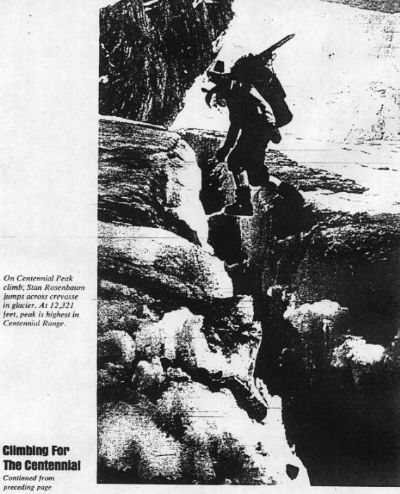|
Climbing For The Centennial In a unique project to celebrate our 100th birthday, the Alpine Club of Canada set out to climb 14 mountains in the Yukon. A report filed by the now defunct, "Weekend" magazine, dated Saturday, October 7, 1967. THE LARGEST mass assault in the history of mountain climbing has drawn to a close in the Canadian North. Nearly 250 climbing enthusiasts, from all across Canada, participated in the three phases of the project. The first phase, the ascent of an unclimbed peak at the Alaska-Yukon border, took place between June 19 and July 7 and involved four Canadian and four American mountaineers. The second, the attempt to climb 13 virgin peaks in the Yukon Territory, started on July 8 and finished on July 23. It involved 52 climbers. The third phase, from July 15 to Aug. 13, was the operation of two two-week camps, where some 200 mountaineers camped by the side of the Steele Glacier and climbed many of the imposing peaks in that area. Of the 14 mountains attempted during phases one and two, the climbers planted Centennial flags on the top of 12.
The Yukon Alpine Centennial Expedition was conceived as a unique celebration of Canada's birthday, and was supported by the Centennial Commission, the Fitness and Amateur Sports Directorate of the Department of National Health and Welfare, the Yukon Territorial Government, the government of the Northwest Territories and the provinces of British Columbia, Alberta, Saskatchewan, Manitoba, Ontario, Québec and Newfoundland. Organization of the expedition fell into the Alpine Club of Canada and the Arctic Institute of North America. The area of the climb was the St. Elias Mountains, a region of the Yukon-Alaska border, surpassed only by the Himalayas and the Central Andes in height and grandeur. One mountain range there, consisting of 13 unnamed and unclimbed mountain peaks, was officially designated the Centennial Range and the individual peaks were named after ten provinces and two territories. They all towered above 10,000 feet and the 13th and largest, at 12,321 feet, was named Centennial Peak.
An additional feature of the expedition was the scaling and naming of Good Neighbor Peak, by a combined U.S.-Canadian team, to celebrate two Centennials -- the 100-year-old purchase of Alaska by the United States and Canada's Confederation. Total cost of the expedition was about $250,000 which included the several hundreds of dollars spent by each individual member in equipment and transportation to the area. Despite some bad weather and dangerous conditions the climbs were made without a serious incident. The month-long expedition took place above the 6,000-foot level, a strange world of ice, snow and rock where no plant or animal life exists. The only forms of life the climbing teams spotted were two humming birds which one day mysteriously appeared, perhaps attracted by the color of the climbers' clothing. It was found impossible to reach the tops of two peaks in the time allotted for the expedition -- Mount Saskatchewan and Mount Manitoba. However, mountain climbers being what they are, it's not likely these two summits will long remain unconquered.
|


